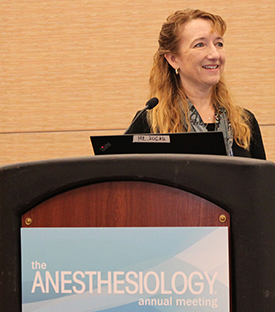
Nora D. Volkow, M.D.: ‘We can do something right now by expanding our training and education of those in the health care system.’
Despite efforts to curb opioid prescriptions, the Centers for Disease Control and Prevention reports that synthetic opioid-related fatalities increased 22 percent in 2016, surpassing deaths related to heroin or prescription opioids.
The U.S. prescribes 80 percent of the world’s opioids, said Nora D. Volkow, M.D., Director of the National Institute on Drug Abuse, who kicked off Sunday’s Journal Symposium, “Frontiers in Opioid Pharmacotherapy.” The over-prescription of opioids is changing prescription practices. But where does that leave patients with acute pain?
“We need to develop better pain medications that will bind to the opioid receptor but not engage the arresting pathway,” Dr. Volkow said.
Drug development is a lengthy process. Meanwhile, to help patients with illicit opioid use, “we can do something right now by expanding our training and education of those in the health care system,” she said. “Initiating buprenorphine in the emergency department reduces illicit opioid use and increases engagement in addiction treatment.”
Buprenorphine buys patients a month of stability in which they can get started with treatment. Extended-release naltrexone also could be a strategy for preventing opioid overdoses. In clinical development are vaccines for heroin and fentanyl.
“It’s plausible that we may be able to treat addictions with a completely different set of tools,” Dr. Volkow said.

Laura M. Bohn, Ph.D.: ‘Now we look at receptors as microcircuit integrators. We’re looking for opportunities to install a dimmer switch.’
Laura M. Bohn, Ph.D., highlighted exciting drug developments in the pipeline that may address the opioid crisis. Dr. Bohn is a Professor of Molecular Medicine and Neuroscience at the Scripps Research Institute. She followed Dr. Volkow’s presentation with a discussion of her research on the signaling capacities of beta-arrestins and the complex nuances of mu opioid receptors.
Dr. Bohn previewed evidence of a study on opioid receptor signaling that will be published in November. It indicates that beta-arrestins genetically regulate mu opioid receptors to mediate certain side effect profiles, such as drug tolerance.
“We don’t know yet if beta-arrestin is actually mediating those effects in vivo,” she said. “But I do know that we have confidence that cell-based assays in our drug discovery efforts correlate very much with a physiological endpoint that we can measure.”
Dr. Bohn said her research team is trying to change the circuitry of target drugs, such as morphine, to ultimately provide the analgesic effect without the side effect profiles.
“We used to think of agonists as a binary system, like a light switch that turned receptors on,” she said. “But now we look at receptors as microcircuit integrators. We’re looking for opportunities to install a dimmer switch.”
Return to Archive Index
